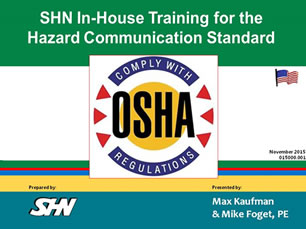Health and Safety
Employee health and safety is critical to SHN’s sustainability, values, and mission; without care and attention to employee health and safety, SHN would not exist. Because employees are frequently working in construction and industrial settings, risks of injury are high. Management spends significant effort and resources on its employee health and safety program, which includes:
- Leadership at the top. The Principal of civil engineering services is the company’s Health and Safety Officer. He sets the tone for SHN’s safety culture by communicating its importance, and how every employee must be aware and involved in the safety program.
- Documented safety program. The safety program’s primary elements are regular in-office safety meetings, general safety training, a hazard communications program, on-site general and daily safety meetings, project-specific site safety plans, and an emergency action plan. The CEO, CFO, and the safety officer meet once per quarter to review the program and its results, and to implement any improvements.
- Personal Protective Equipment (PPE). SHN provides PPE, which includes “hard hats,” respirators, safety vests, face shields, safety glasses (including prescription eye glasses if needed), goggles, hearing protection, gloves, steel-toed boots where warranted, and full “Tyvek” suits. A project’s site safety plan documents what level of protection is necessary, and employee compliance is mandatory; willful disregard is sufficient for termination.
- Compliance with state and federal laws and regulations. The Occupational Safety and Health Administration (OSHA) is the federal agency that issues regulations for worker safety, but California and Oregon have OSHA-Approved State Plans (OSHA, 2014). OSHA regulation coverage is extensive; examples of coverage are regulations for trench shoring, “Workers’ Right to Know” about hazardous chemicals in the work place, and protection against retaliation should an employee report violations (“Whistleblower Protection”).
- Hazard Communication Program. Work place hazards are communicated via the above safety program channels, but specific to chemical hazards, SHN provides information and instruction on proper container labeling, how to read Materials Safety Data Sheets, training on the use of PPE, and training on what to do in case of exposure.
 Slide #1 of in–house safety training sessionIn-office worker health and safety is also an important aspect of SHN’s program. Repetitive injuries, lifting injuries, and sedentary conditions are risks of any office work. These issues are also included in OSHA regulations.
Slide #1 of in–house safety training sessionIn-office worker health and safety is also an important aspect of SHN’s program. Repetitive injuries, lifting injuries, and sedentary conditions are risks of any office work. These issues are also included in OSHA regulations.
Employee mental and physical health affects company performance. Employees accrue vacation and holiday pay and are encouraged to use the “days off.” Sick leave is also an accrued benefit, with no limit on accrual. Besides being used when an employee is sick or going to medical appointments, the benefit can also be used to care for a sick family member.
SHN provides health insurance to those employees and their families who are eligible (eligibility depends on number of hours worked per week). SHN pays a portion of the premiums. A “cafeteria plan” is also available such that employees can contribute pre-tax funds to pay for their share of health insurance premiums, any uncovered medical expenses, and dependent (child or elder) care.
Employee health is also supported by corporate membership discounts at health and fitness centers at the Eureka office. Showers are available at the Eureka, Redding, and Willits offices.






